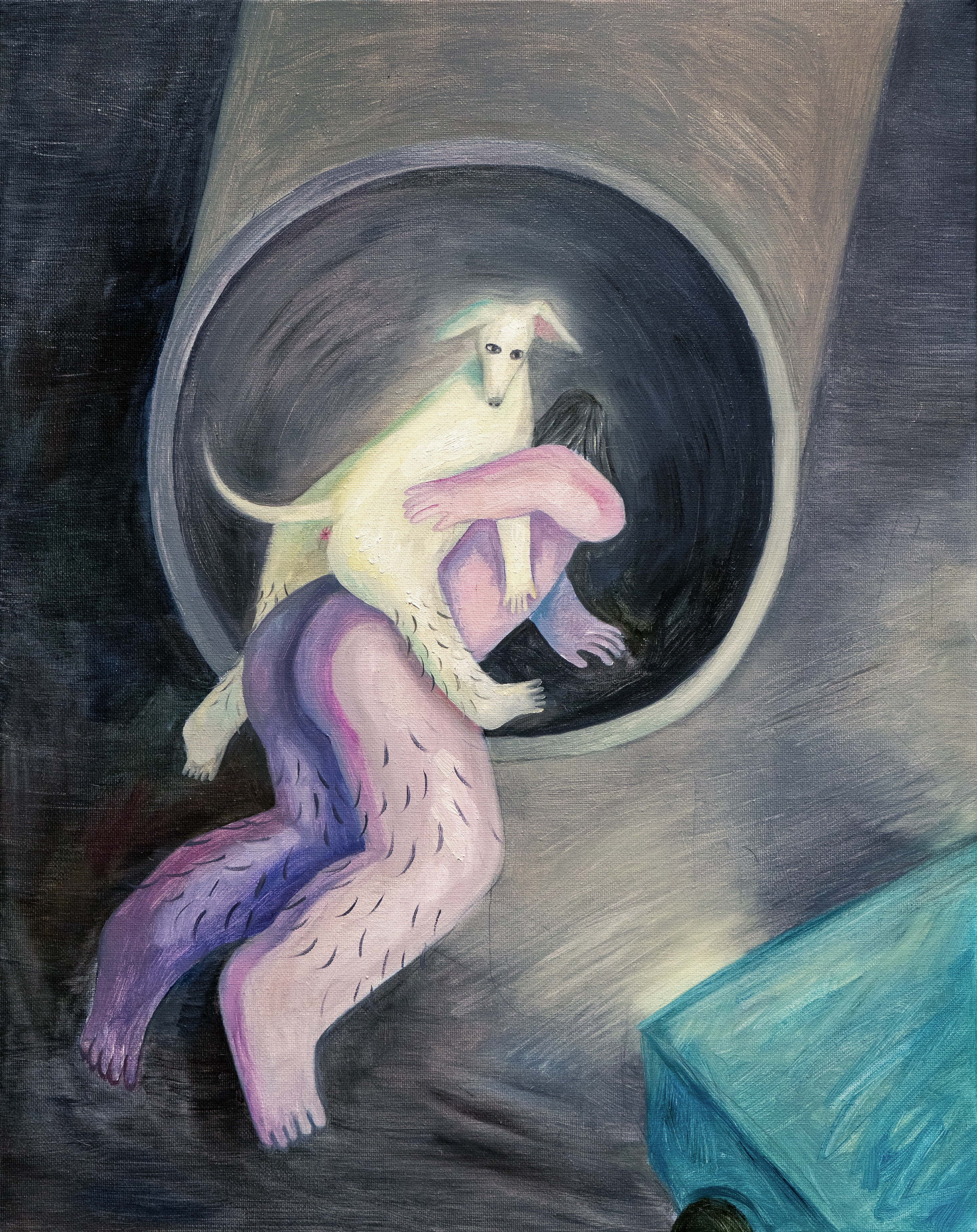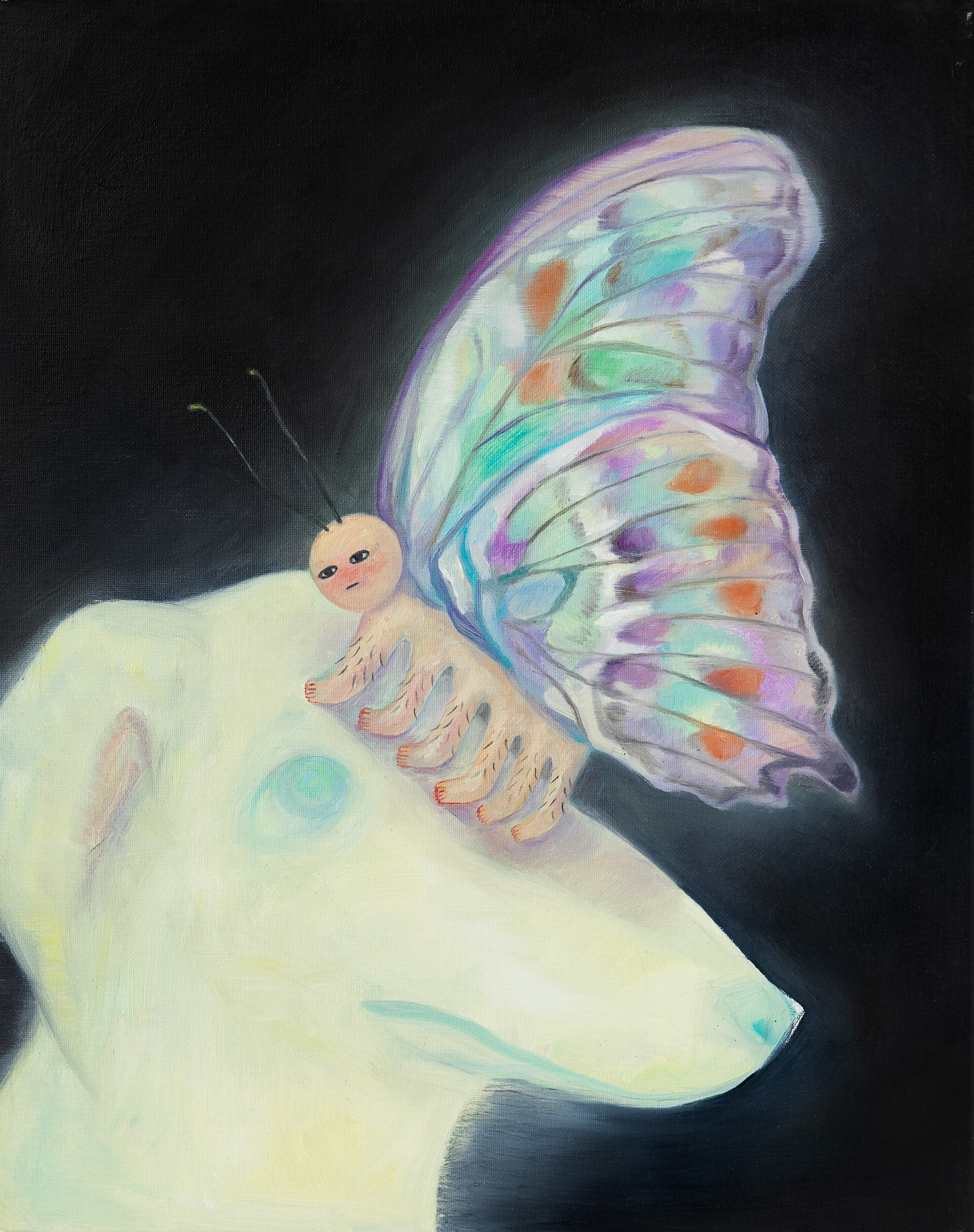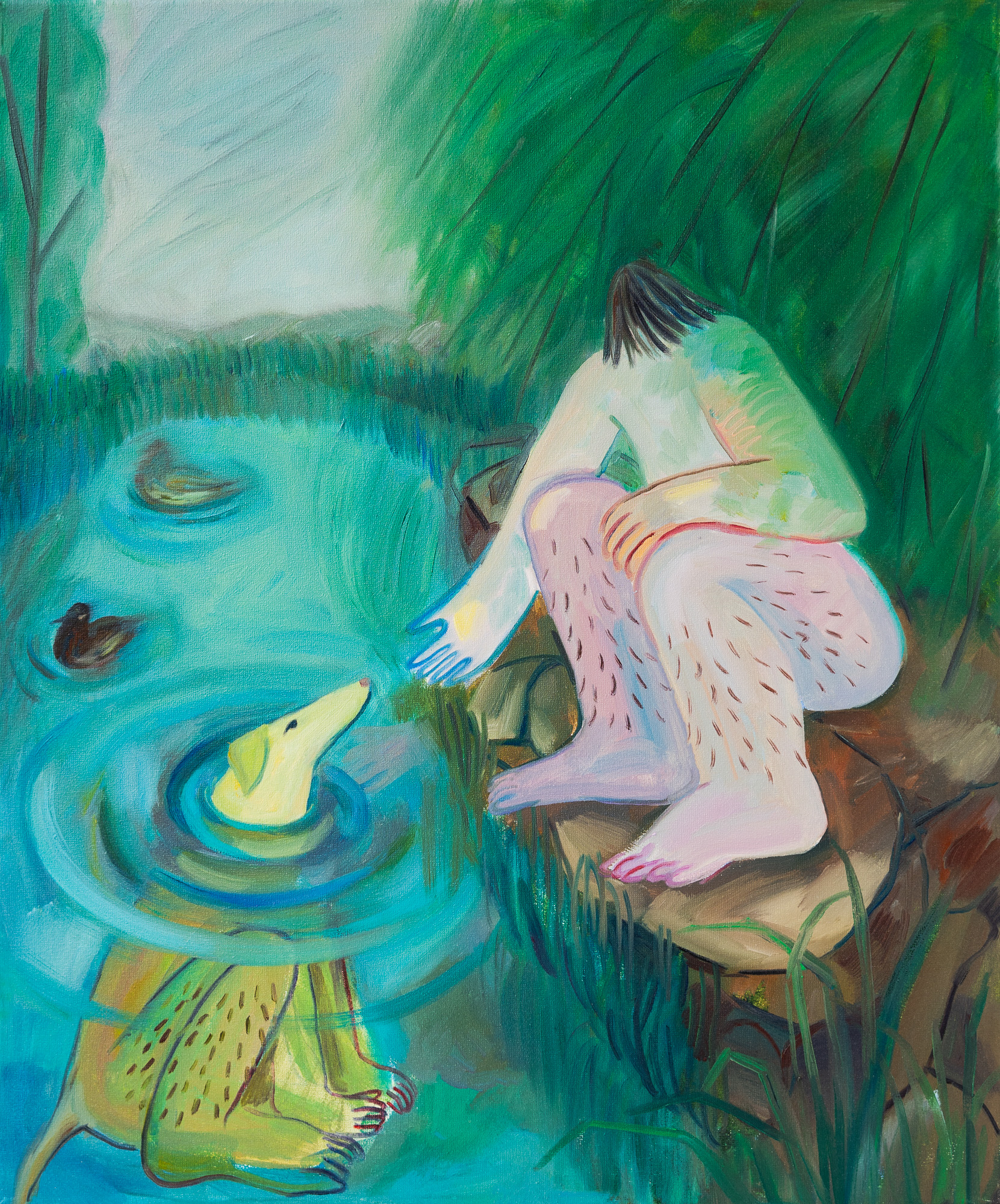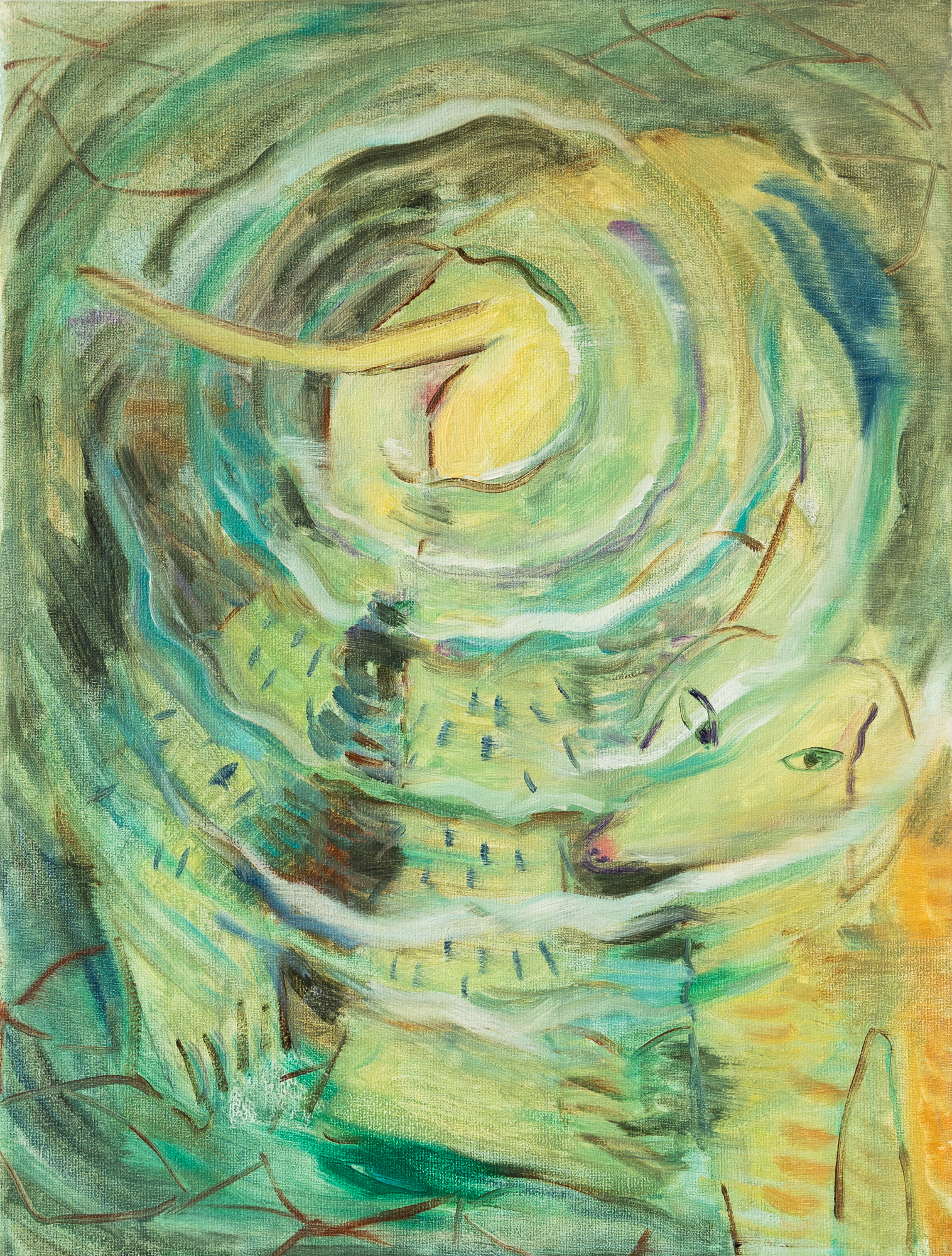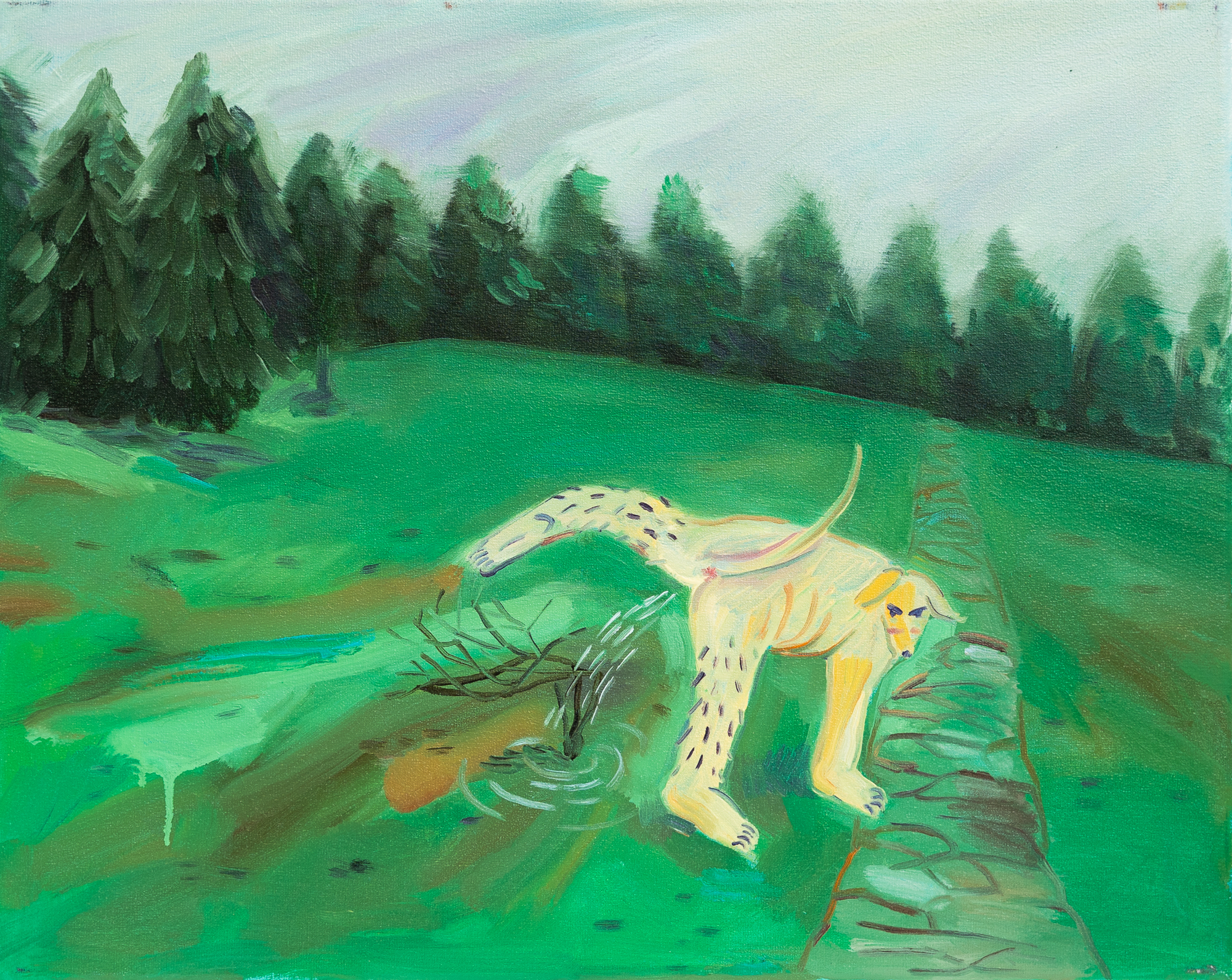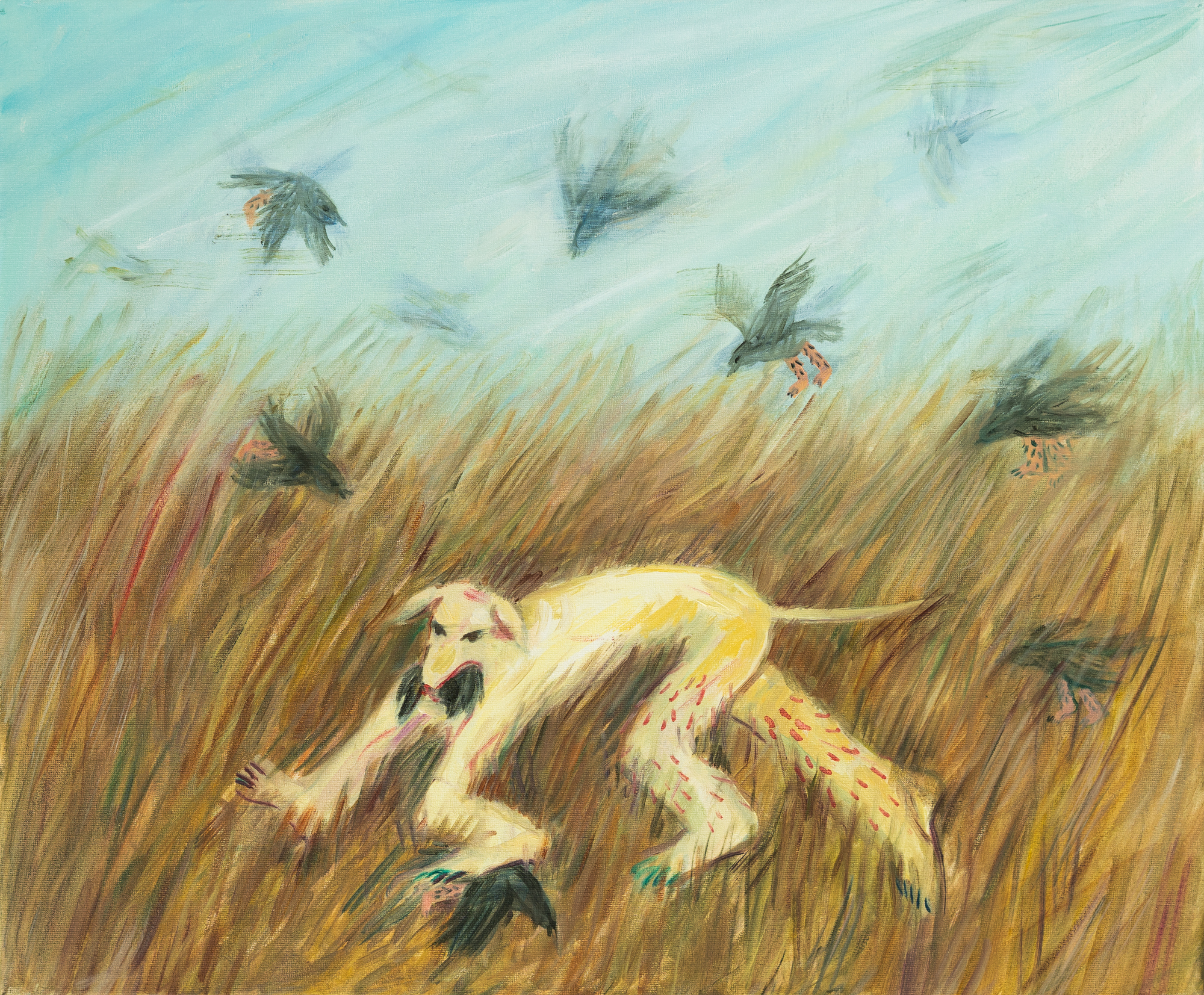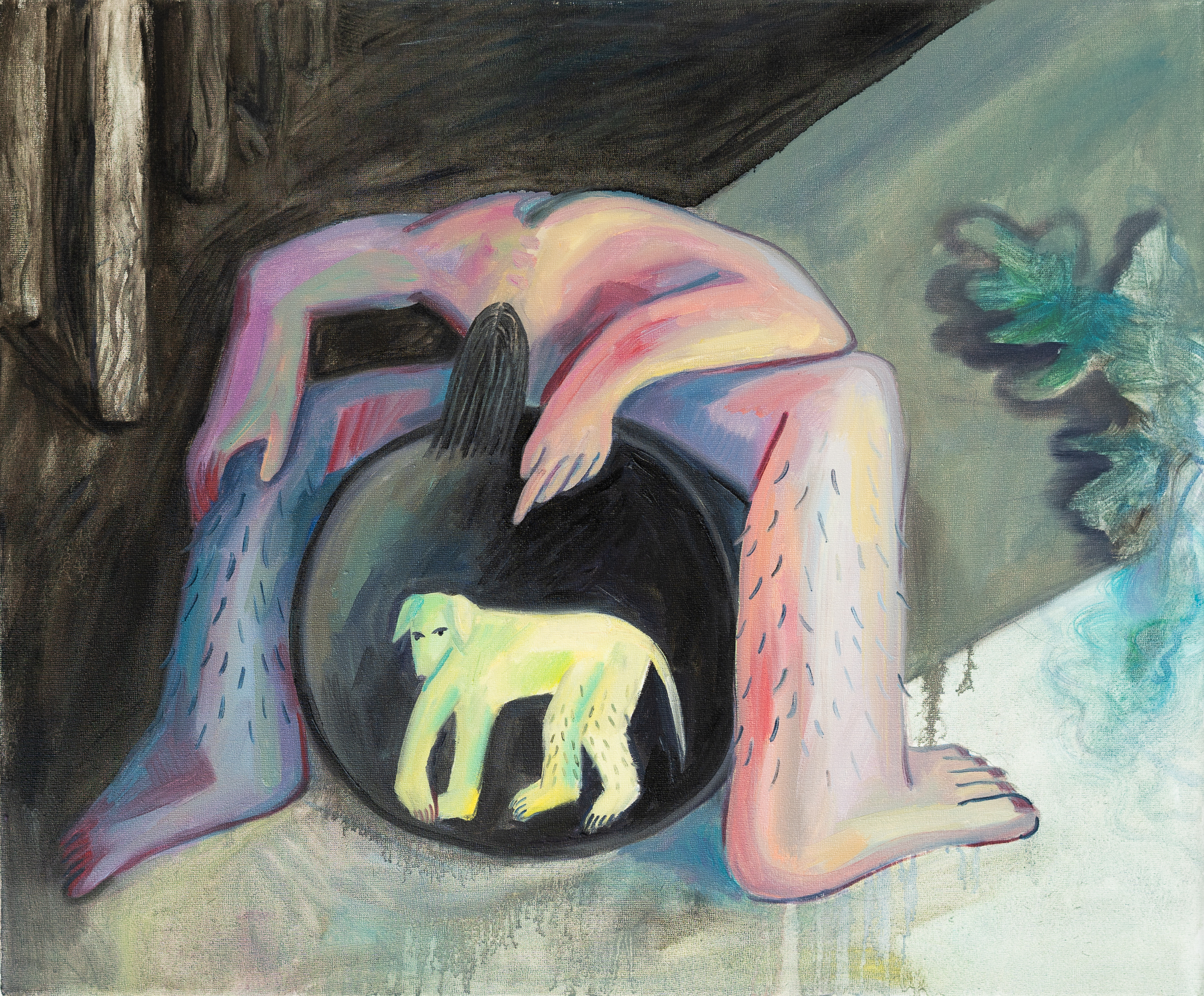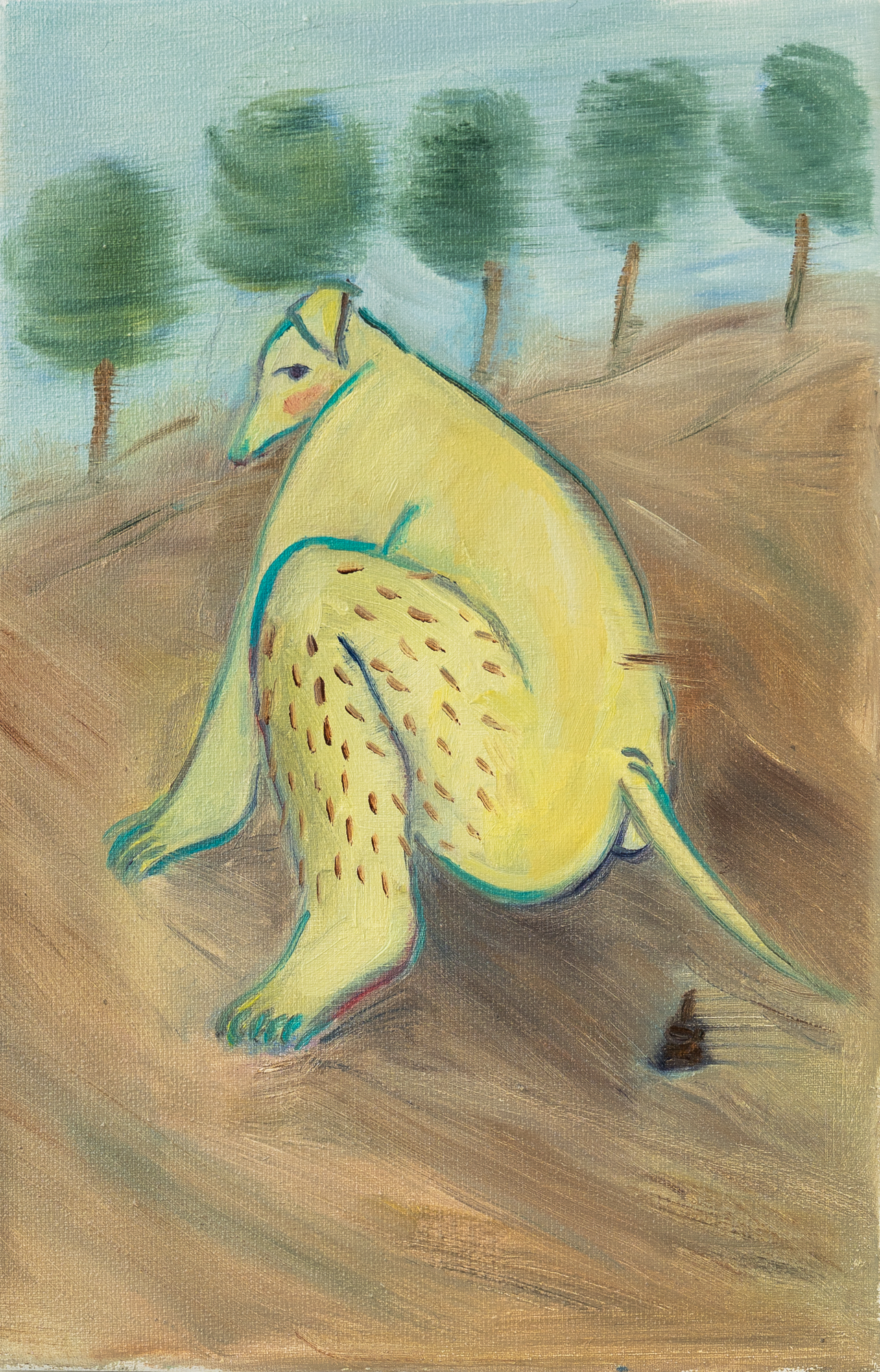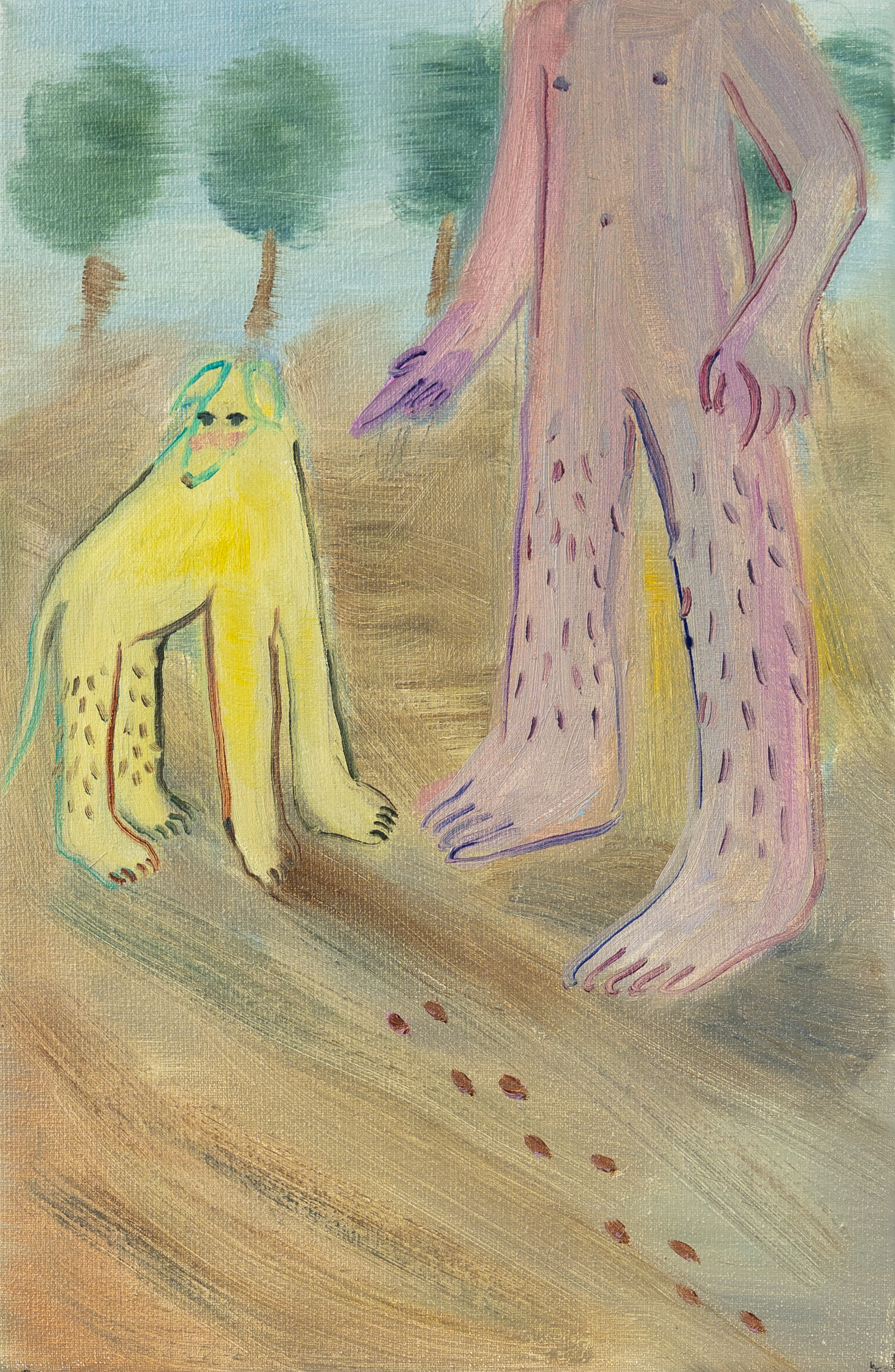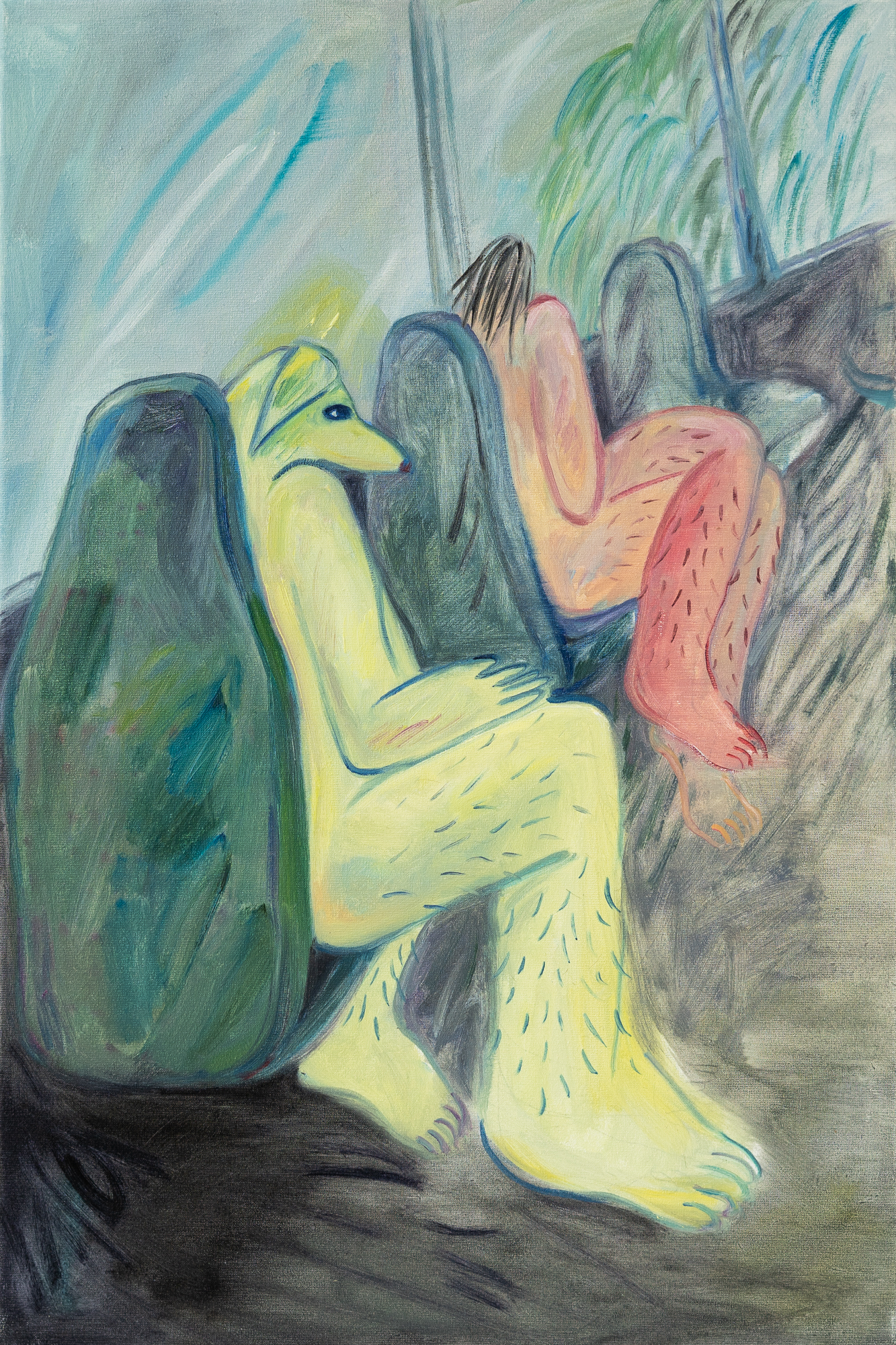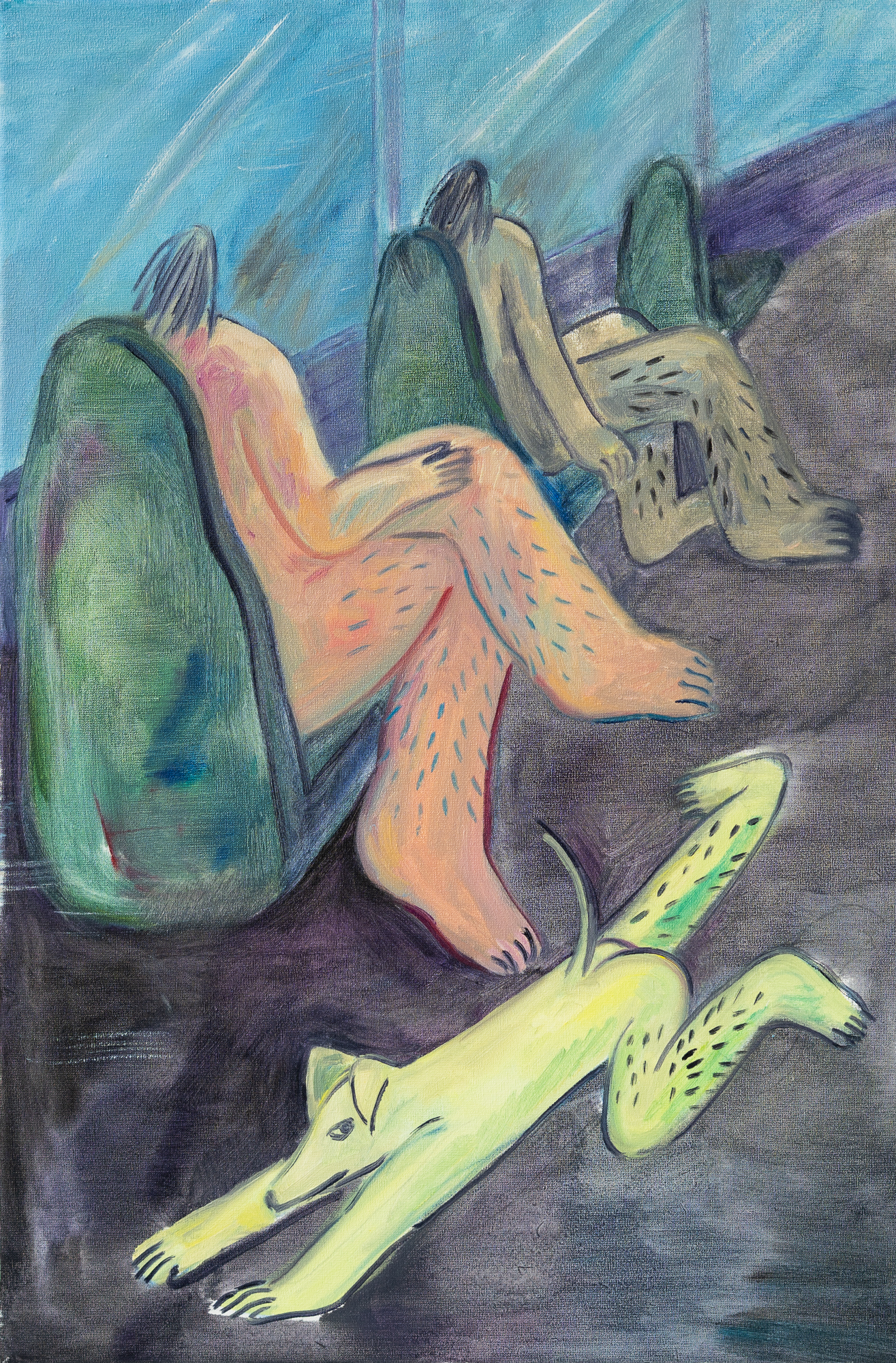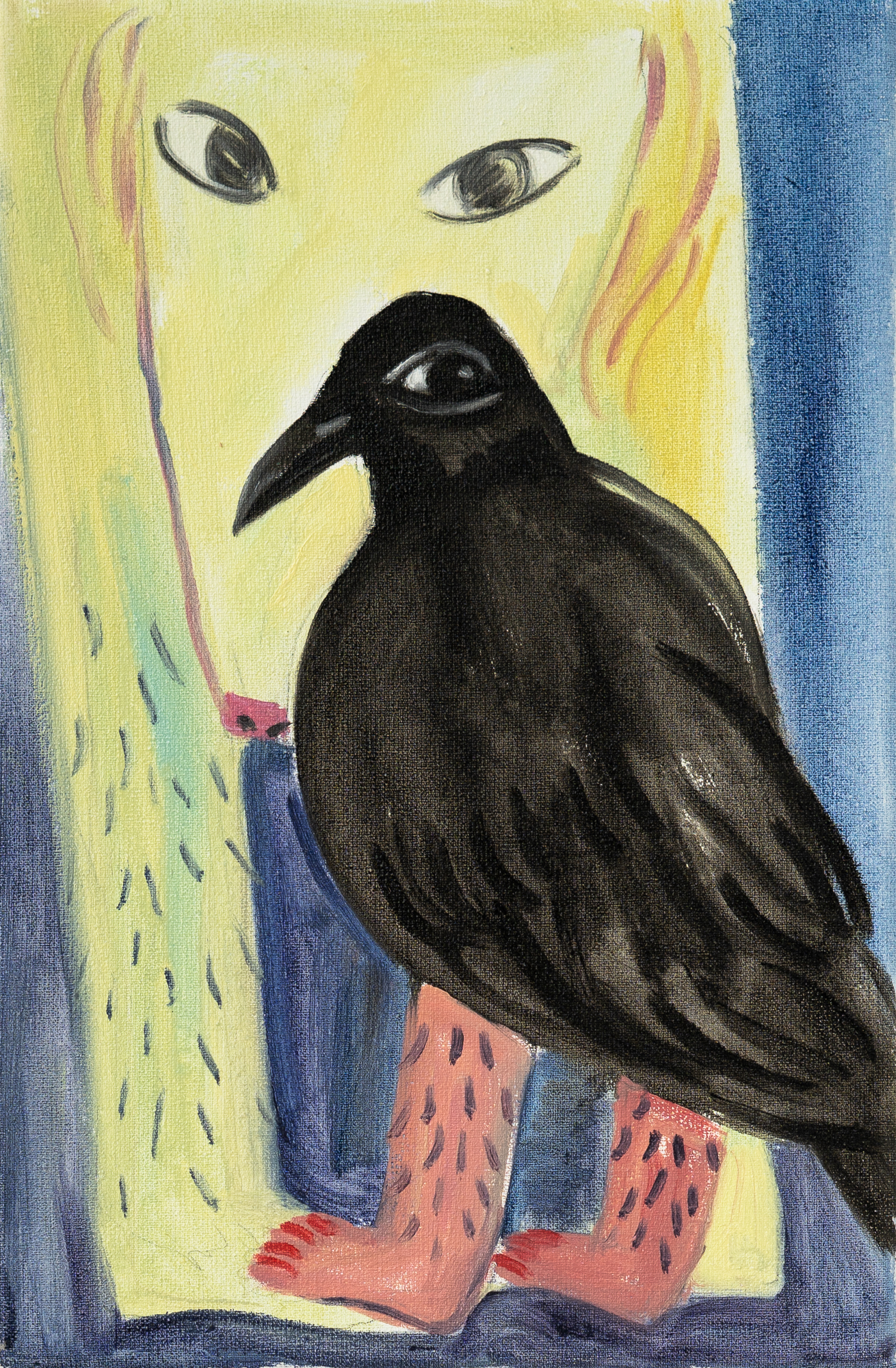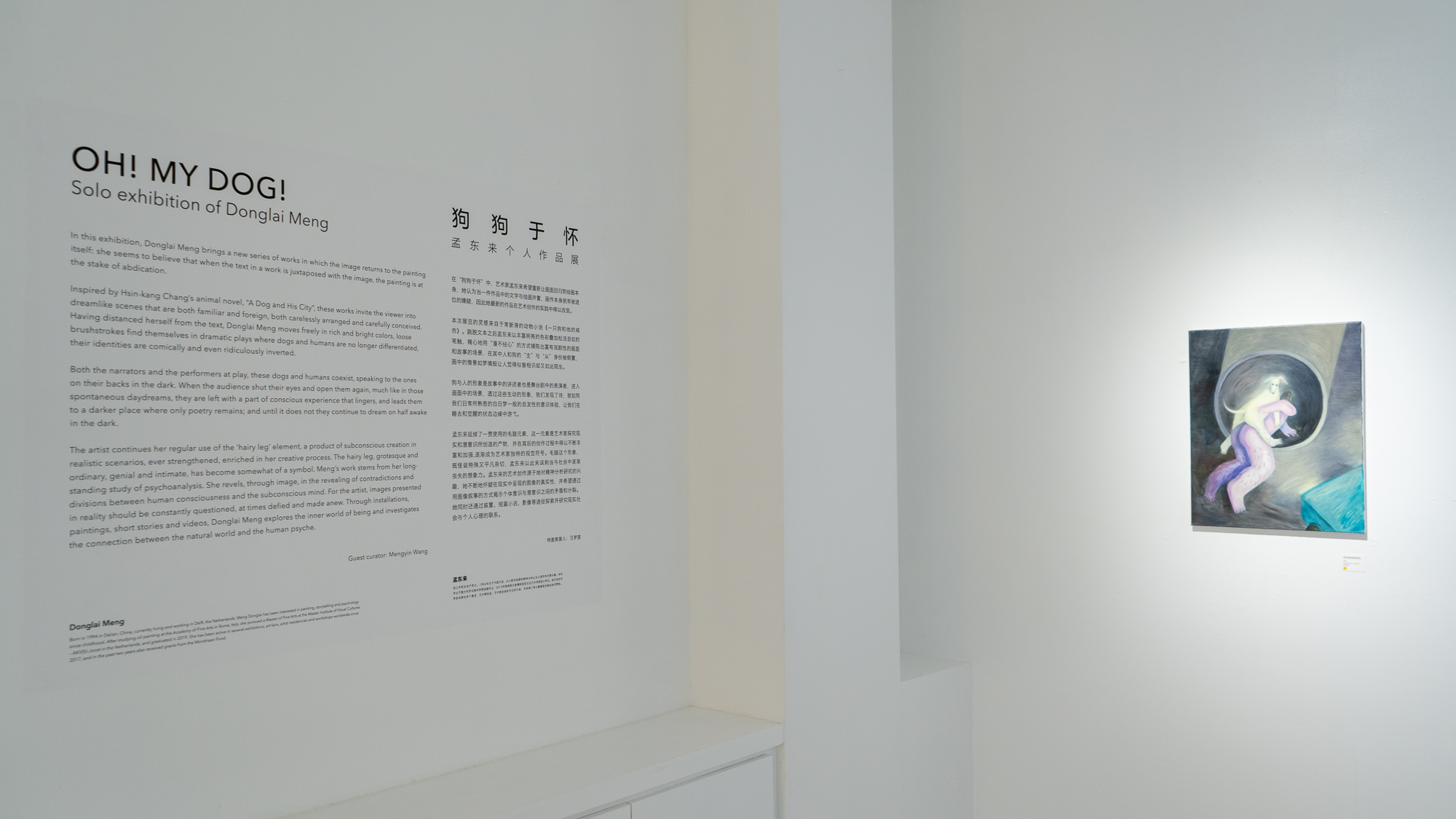
Oh! My Dog! 狗狗于怀
SOLO project in CHA x ART, Amsterdam, the Netherlands, 2022
Invited curator: Mengyin Wang








EXHIBITION TEXT
In the exhibition ‘Oh! My Dog!’, Meng Donglai (China, 1994) brings a new series of works that differ from her previous ones in that she, the artist, did not actively ‘construct’ the paintings in ways of creating a storyline or integrating a context into the image (for comparison, in her 2021 residency at Nieuw en Meer in Amsterdam, she created ‘Murder’, a fiction-based work where drawing and text are juxtaposed). These new works position painting itself in its neutral and transcendental stance, and thus invite the viewer to imagine its language and emotion, and possibly empathise with the image from within.
In fact, Meng’s earlier works are quite striking already: What she created is a world of fictional killers but also a world so vast and in a way, secure, where she could happily retreat and revel in her imaginations; when her peers were reciting quotes in class, the artist was already making use of her imaginative gift for her own recital. Her long-standing obsession with psychology does manifest itself in her work, which serves as an important medium to combine rhetorical devices with pictorial performance. In this new series of works Meng Donglai has returned to the painting itself: she seems to believe that when the text in a work is juxtaposed with the image, the painting is at the stake of abdication.
Both the narrators and the performers at play, these dogs and humans are natural revelations under her brush. Their immediate existence does not ask for cause and effect, or the relationship between the image and the prototype that may be deeply rooted in the subconscious. Here, dogs and humans coexist, speaking to the ones on their backs in the dark: When the audience shut their eyes and open them again, much like in those spontaneous daydreams, they are left with a part of conscious experience that lingers, and leads them to a darker place where only poetry remains; and until it does not they continue to dream on half awake in the dark.
The artist as poet likes to turn her inner states into descriptive language in the form of image, and this points to a phenomenology of imagination which is productive, resounding, and full of life. In an instant, we are confronted with an image quiet, to the rim of evasiveness. The viewer’s intuitive feeling upon seeing the image, could be given by the artist intentionally or unintentionally. Those playful forms in her work only invite the viewer to be there, to see and feel: they do not ask for analysis. As the French philosopher Gaston Bachelard reminded us at the beginning of La Poétique de l'Espace, it will not work when a philosopher adheres to customary principles surrounding philosophy of science and applies Rationalism to the practice of studying poetic imagination. The image of poetry is not unlike the image of painting, or rather, the image of painting can truly empathise with the image of poetry. The act of creating the image has in itself no past, it knows no history, no clues to be connected at a later event back to its process and completion. What Meng Donglai brings to the forefront in her new works is a possibility of intrinsic aesthetic pleasure, which does not require knowledge of the viewer, nor does it try to educate or influence. Freed from formalism and ideology, this pleasure belongs to everyone. When the painting’s political connotation is largely removed, the questions of what to paint, how to paint, for whom and to what end, remain intact in the pure painting itself, in its ‘flatness’ and narrativity, regardless of external categorisation and for that matter confrontation, regardless of the high and the low, the right and the wrong.
Perhaps indeed, to forget certain rules and logics can come as helpful to our ways of seeing, of being with the image. At this point, perhaps, it feels out of place to analyse her paintings from the perspective of psychoanalysis or rather any perspective. It is more than necessary and important to give control to the viewer, in whose interaction with the work, meaning is enacted and created anew. The artist, in her 0-to-1 process of creating, offers us a possibility of entering dream-like scenes in a parallel time and space to our everyday life, and we as spectators are therein given the strength of imagination, to imagine, dream along, and to feel the kind of aesthetic pleasure in dreaming.
The artist neither explains nor answers. After abandoning principles and reasons in paintings, Meng Donglai has discovered and cultivated various relationships from which pictorial illusions are created and maintained. Dreams and fantasies become real in the construction of the world and the self. The simulacrum resides in and at the same time is detached from the act of imagining, whereby the pleasure beyond the tamed body and mind is obtained at last. In a time when many are accustomed to escape rather than confront, these paintings strike as they confront, in them the poetic and physical perceptions are worked towards the point where dreams become the world, and vice versa.
孟东来(中国,1994 年)在茶集空间的⾸次展览“狗狗于怀”中为我们带来了全新的系列画作,这些新作品与以往创作不同,孟东来不再主动为画作构建⼀个故事或添加⽂字性的情境背景 (如 2021 年她在阿姆斯特丹 Nieuw en Meer 驻留期间创作的虚构故事——“谋杀案“,以虚构⼩说为基础的绘画与⽂字并置的作品),⽽是将绘画置于其中⽴且先验的⽴场中去,让观者 对画⾯语⾔与情感⾃⾏想象并将⾃⾝同理于画⾯中。
实际上她在年少时的创作就给我带来了震撼——庞⼤的虚构杀⼿世界,当其他同龄⼈都在背诵名⼈名⾔和写作⾦句的时候,她就已经拥有可以将⾃我进⾏藏匿的安全世界,我想她天⽣就被赋予丰富的想象⼒。她曾痴迷于⼼理学研究,绘画于她⽽⾔是集⾔说与画⾯表演于⼀⾝ 的重要媒介。在这次展出的作品中,她重新让画⾯回归到了绘画本⾝,她认为当⼀件作品中的⽂字与绘画并置,画作本⾝就有被退位的嫌疑,因此她最新的作品在艺术创作的实践中得 以改变。
狗与⼈的形象是故事中的讲述者也是舞台剧中的表演者,它们是孟东来笔下⾃然⽽然流露出的⽣动图像,这些形象是⼀种直接存在,不同于⼀般定义中的因果关系,即形像、画⾯的空间和创作者潜意识深处的原型的关系。进⼊画⾯中的场景,透过这些形象,我们发现了诗,这种如诗般的体验,就如同我们⽇常所熟悉的⽩⽇梦⼀般的⾃发性的意识体验,让我们在睡去和觉醒的状态边缘中游⼷。
孟东来如同⼀个诗⼈,她愿意记录内⼼活动的真实图像,这种创造是想象⼒的现象学,像诗中⼀句句迎⾯⽽来的形象,它们饱满也充满回响(retentissement),画中诗意的瞬间形象静谧却逃逸,观者看到形象的最直观感受是孟东来有意或⽆意中给予的,作品充满游戏性的形态,对于观者⽽⾔,⼤前提是到场⽽不是分析。对于欣赏作品这种主观活动,我描绘再多的⽂字也⽆法让⼈产⽣到场的体验,如同法国哲学家加斯东·巴什拉(Gaston Bachelard)在《空间的诗学》(La Poétique de l’Espace)开篇就提到的观点,若⼀个哲学家,秉承惯有的围绕科学哲学的基本问题形成的理性主义来研究诗歌想象⼒所提出的问题,是⾏不通的。诗歌的形象 我愿意同理于绘画的形象,或者说绘画的形象同理于诗歌的形象更为贴切。这种形象的创作⾏为没有过去,“⾄少没有紧密相连的过去可以让⼈追踪它酝酿和完成的过程”。尼采也提出"知性中了艺术家的圈套”。孟东来的新系列带给⼤家的是真实的审美愉悦的可能性,对观者既没有知识上的要求也不为教育或感化任何⼈,为艺术⽽艺术,摆脱形式主义的意识形态和内容, 从⽽做到“政画分离”,画什么与怎么画都在其绘画的平⾯性与叙事性中回到⾃⾝的纯粹⾥去,不分性别与⾝份认同、不分⾼低贵贱也不分对与错。
也许忘掉⼀些规则和逻辑能让我们更加陶醉于这些形象的⽚段中,也许对于分析画⾯以及⽤⼼理学研究中的精神分析法来判断创作者的性格及诸如此类的出发点此时就变得不合时宜了。 观者与作品的内在互动是⾮常重要,也是必要的。艺术家在由 0 到 1 的创作过程中作为⼀个 造梦者向我们展现⼀个个不思议的平⾏时空中的⽇常,我们只需要想象⾃⼰作为⼀个做梦的⼈,将梦作为⼀种外观,或者将梦看作对外观的原始欲望的⼀种更⾼满⾜。此刻的观者必须是⼗分清醒的旁观者,⼜是参与其中的重要⾓⾊。
孟东来不再去解释和给出答案,摒弃绘画中的基本原理和规则,在各个关系中去发现与栽培,制造⼀幕幕幻象。对世界和对⾃我的构建,梦境与幻想将都变为真实而非虚拟,它们是拟像化的真实,在梦境中,在想象中,在虚幻中获得被驯服的⾝⼼之外的愉悦,成为⼀种现代现象。在⼀个特殊世代中,⼈们习惯性逃逸,但创作者的画⾯触发了⼈们脑海中的诗意与⾝体性感知,透过绘画当中的回响,让我们真正了解存在物、存在主体的意味。
——by Mengyin Wang
